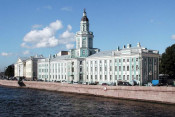
Peoples of Russia and Museums: New permanent exhibition “Imperial Hall: Multicultural Russia” opens in the Kunstkamera in St. Petersburg
On November 2, 2022 the official opening of the new permanent exhibition Imperial Hall: Multicultural Russia takes place in the Peter the Great Museum of Anthropology and Ethnography (Kunstkamera).
The new exhibition Multicultural Russia is the main link of the project on the general re-exposition of the Kunstkamera. It is based on the key episodes of the formation of the national idea of Russia as a multicultural empire – the carnival of the peoples of the 1740s that complemented the attractions of the Ice Wedding and the Ice House, organized in St. Petersburg by order of Empress Anna Ioannovna. Over 150 peoples of Russia took part in this festival of the XVIII century, while the celebrations were prepared by the court, as well as the Academy of Sciences and the Kunstkamera. Since then, the national idea of Russia as a “country rich in peoples”, a multicultural empire has been formed.
Scientific knowledge about the peoples and their costumes, collected in the Kunstkamera, became the basis for the peoples studies (ethnography), including the first ethnographic code in history by the academician J. G. Georgi. Throughout the imperial era, Russia preserved the identity of the “country of peoples”, which is evident in the porcelain series Peoples of Russia presented in the exposition and created for the 300th anniversary of the House of Romanov by order of the last Russian emperor Nicholas II under the scientific supervision of Director of Museum of Anthropology and Ethnography, Academician V. V. Radlov. A part of collected by academic expeditions costumes is displayed in the new exposition alongside the so-called “imperial collections”, gifted to the museum by representatives of the House of Romanov in different times.
In order to expand the scientific and information space of the exposition and to create the effect of travelling through time and space for visitors, there were used audiovisual compositions and interactive means, fit in the interiors and made in view of the latest developments in the field of museum technologies.

